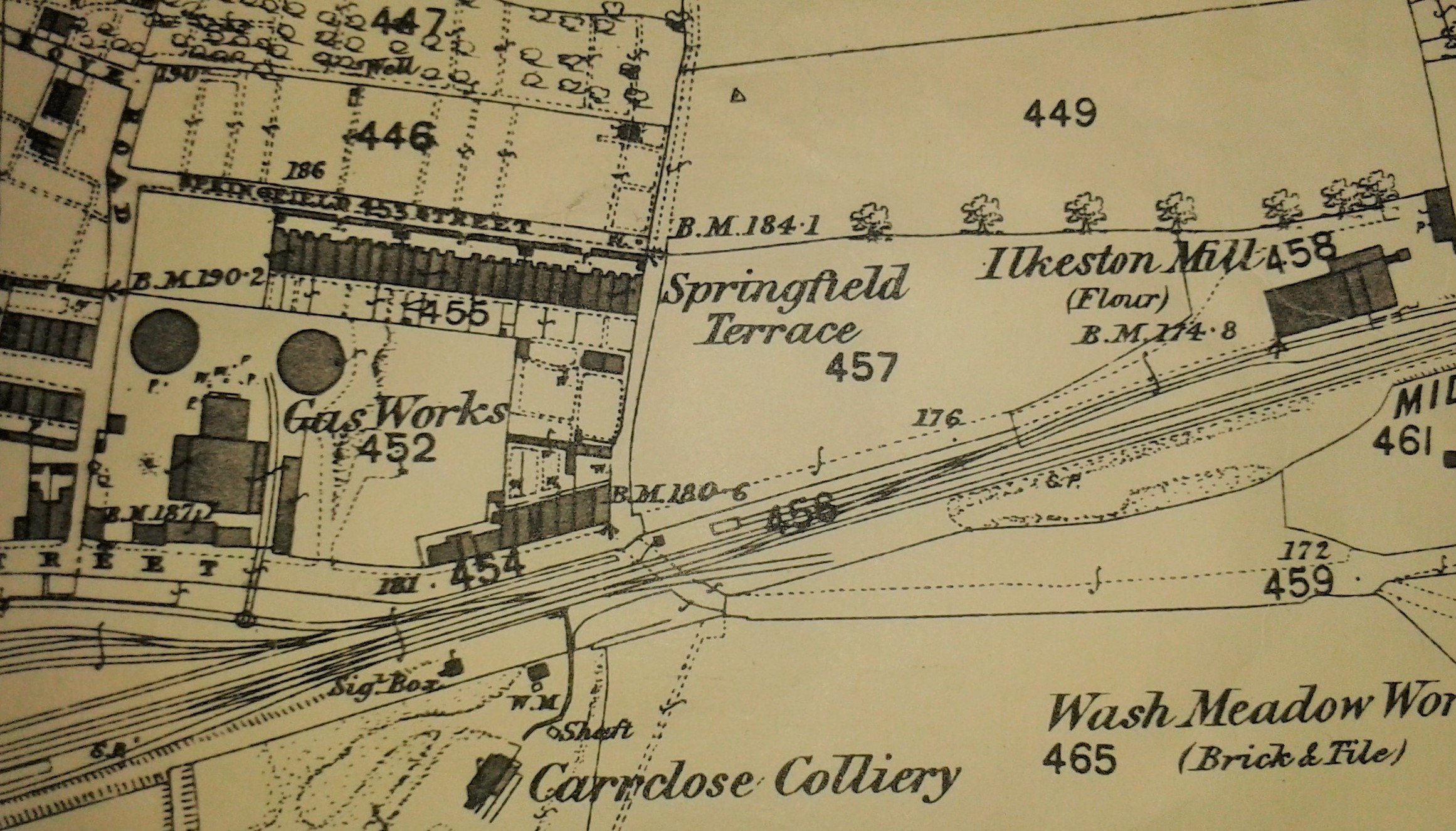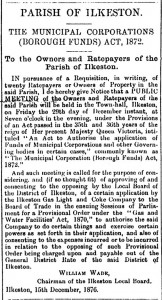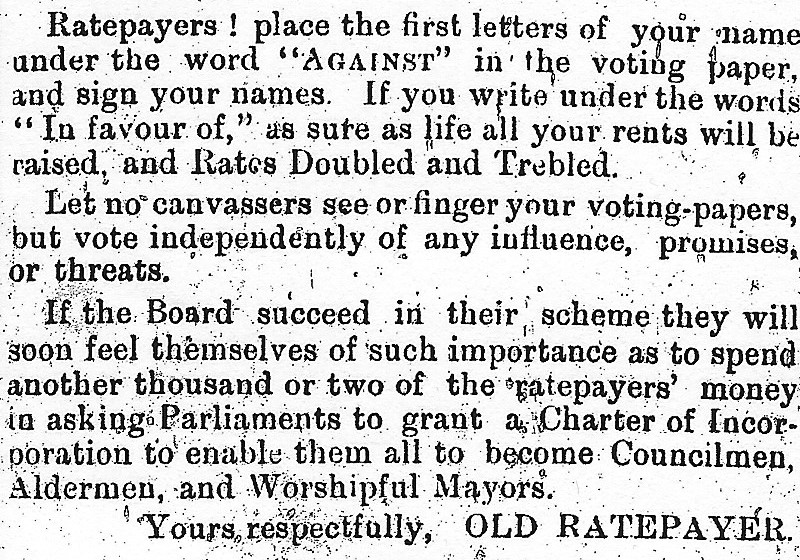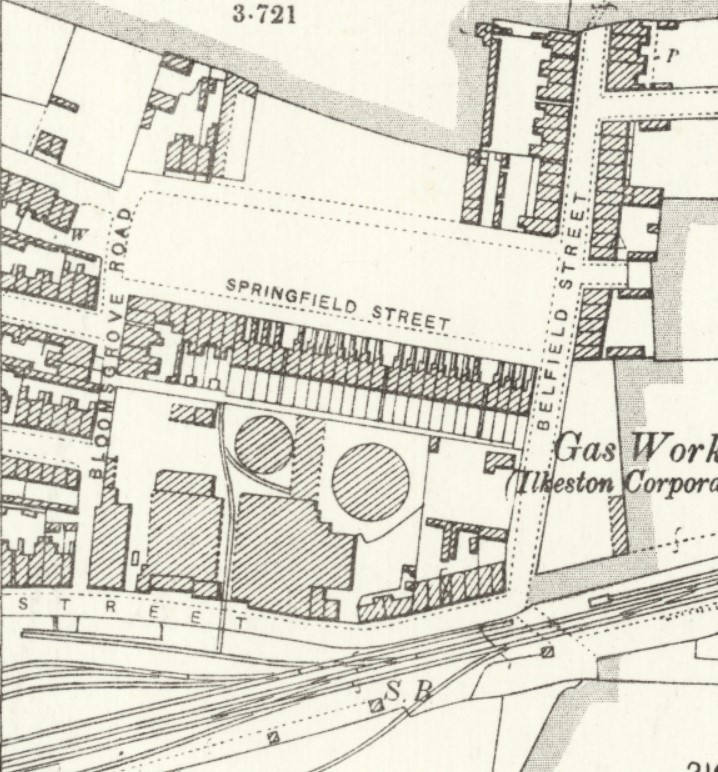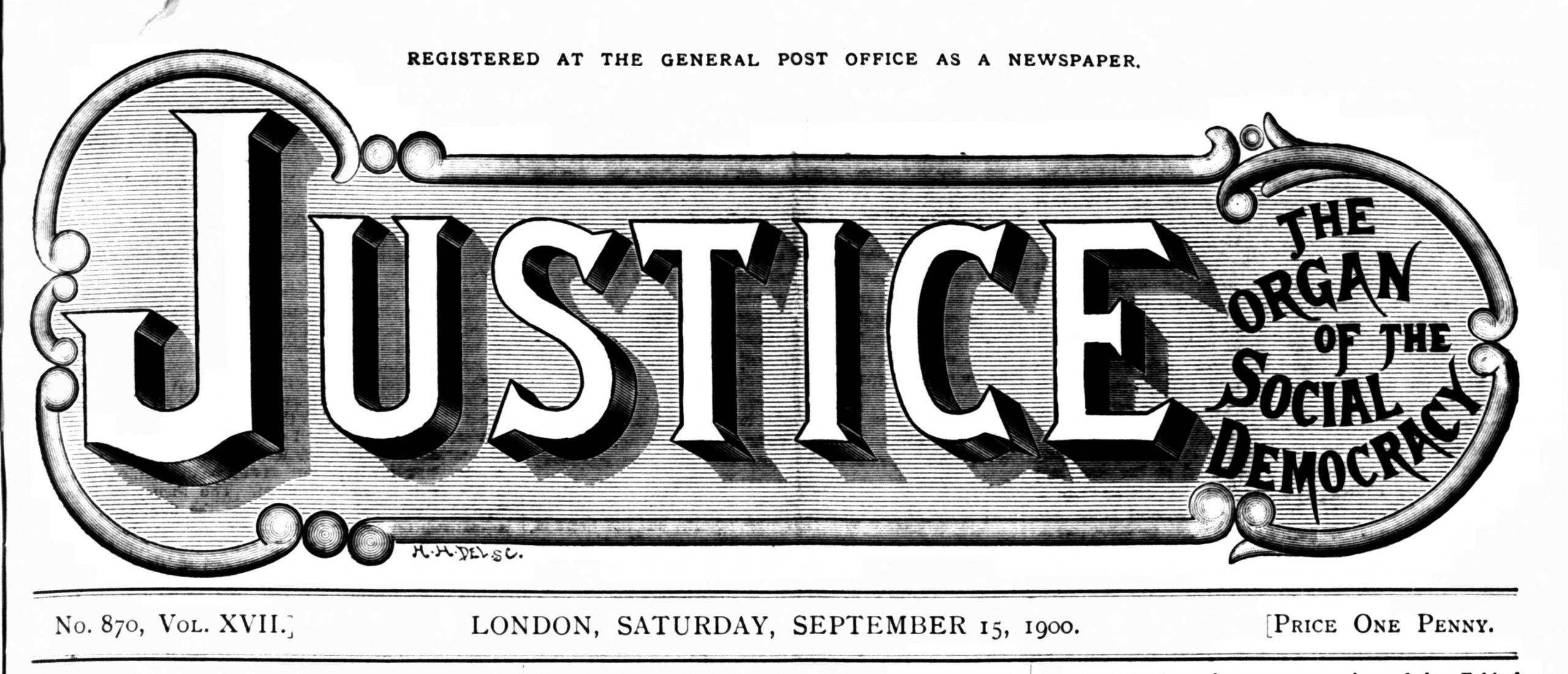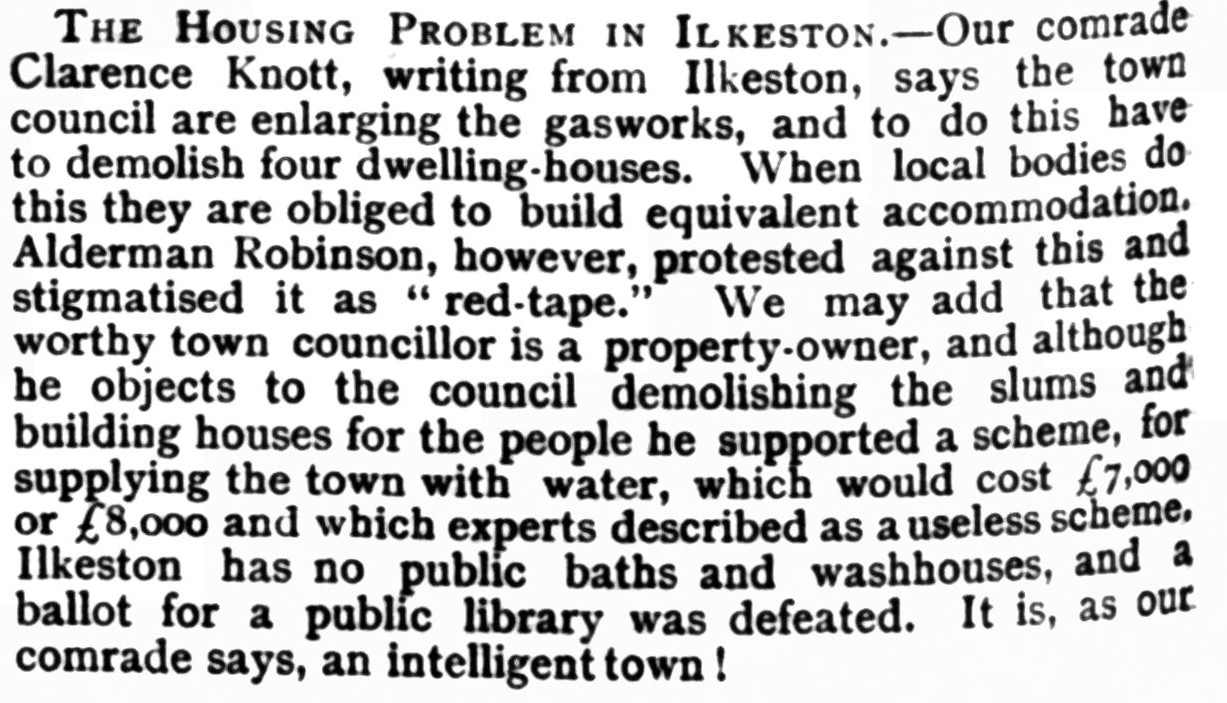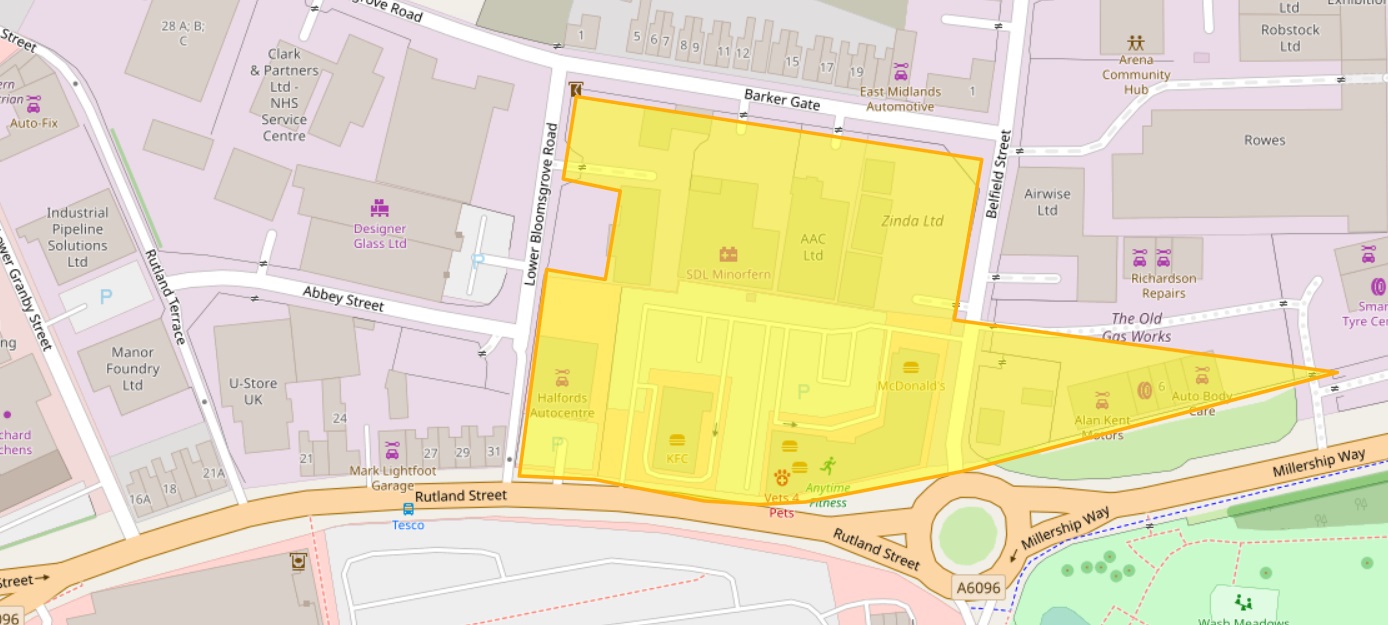Scene: Ilkeston in conflict.
After the 1869 Election Crisis came more confrontation….
The Gasworks move across the street c1869 … and then prices are raised !!
In 1868 a letter in the Ilkeston Telegraph noted that the Gas Company had just started work on “New Works, in front of the houses called ‘Whitehead’s Row’”. Additional land and plant were purchased, and 330 additional shares at £6 10s each were issued to help finance the expansion. These were sold by auction on the open market and each realised £8 6s 4d. This was probably the time that the Gas Works were moved from the original site on the south side of Rutland Street, to the north side (see map below)
In 1872 the Gas Company regrettably had to raise its prices due to the very high price of coal.
For the same reason it tried again in 1873 but the Local Board decided to allow the town to remain in darkness rather than pay the increased tariff, though its ‘gas strike’ was soon called off when the Gas Company agreed to charge a more acceptable rate.
In 1874 more shares were issued by the Gas Company, bringing the total amount of capital up to £13,180 15s 8d.
Complaints 1874/5
In the winter of that year the Company ran out of coal and as a consequence street gas-lamps were not lit, some factories had to close for want of light, and the railway station had to improvise with oil lamps.
A few months later the British School rooms hosted a meeting of disgruntled gas consumers, unhappy with the high price of gas and its uncertain supply. It was reported by draper William Smith of the Market Place that gas in Sheffield and Birmingham was much cheaper while in Walsall it was less than half the price of Ilkeston’s gas, and of much better quality too. If the Local Board were to take over the Gas works he was sure supply would be ensured at a reasonable price.
Thus a resolution was passed, “that a Gas Consumers’ Defence Association be formed to guard the interests of the gas consumers of Ilkeston, to secure gas of good quality and sufficient quantity, and at a lower price”, and a committee was formed to carry out the wishes of this fledgling association.
Shortly after this, a petition was presented to the Local Board, signed by over 150 tradesmen, gas consumers and ratepayers, requesting the Board to purchase the Gasworks “in order to provide a more satisfactory supply of gas for the town”
The third Public Health Act of 1875 gave Local Boards considerable powers over the provision and regulation of gas supply and allowed them to purchase gas companies. Perhaps with this in mind the Ilkeston Local Board then began to express much dissatisfaction with the services provided by the Gas Company.
1876/7. A possible Local Board take-over ? And a fight-back by the Gas Company.
Was the Board preparing a ‘takeover’ of the Gas Works?
Before that question could be answered the Ilkeston Gaslight and Coke Company threw a spanner in the works … metaphorically.
At the end of 1876, it announced its intention to apply to the Government Board of Trade, under the Gas and Water Facilities Act of 1870, for a Provisional Order. If granted, this Order would enable the Company to continue the production of gas at its present site in Rutland Street and, if necessary, to enlarge, alter and repair their works.
You can see the Gas Works on the 1880 map above. They were described as being on a piece of land between Rutland Street (previously known as Slack Road) on its south side (where you see number 454), on the east by some cottages belonging to Henry Bostock and others (just above 454 ?), on the north by other cottages belonging to Richard Whitehead (455 on the map, Whitehead’s Row? called Springfield Terrace on the map ?), and on the west by a private road (called Bloomsgrove Road on the left hand side) which separated the Works from more cottages and land belonging to Frederick Shaw.
The Order would also bestow statutory powers upon the Gas Company “to acquire certain rights and privileges it does not at present possess … such as the power to supply with gas any part of the town it thinks fit, to levy rates, rents, and charges for such supply, to break up the roads, alter or divert the sewers, drains, pipes, and to act … in a degree independent of the local authorities”.
The Company might also raise finance through the issue of more shares, or by a loan, and buy more land for expansion if necessary.
In return, the Company would give up its unregulated status and be subject to more stringent government scrutiny.
It would also be restricted by regulations as to price, quality and pressure of gas and the amount of dividend to shareholders.
And it would be subject to the Gas works Clauses Act of 1847 – which it had previously escaped – and the Amendment Act of 1871, which together required the Company to keep its accounts in a particular form and to publish them annually.
To support its application for the Provisional Order the Company employed Nottingham gas engineer Matthew Hill Loam to examine Ilkeston Gasworks and estimate its value.
He found them “in good working order and sufficient for ordinary purposes” although they required new purifiers and more storage. They were worth well over £12,000.
“Ilkeston was hilly and scattered, there were nearly nine miles of mains, and the hills added difficulty of supplying gas. (Mr. Loam) did not wonder at complaints of the bad light given by the public lamps, because there was an excessive distance between the lamps. Some of them were 150 feet apart. The usual distance was from 60 to 100 feet. He thought the good people of Ilkeston were very well served”. (DM)
This action by the Company aroused considerable debate within sections of Ilkeston society and as usual the Pioneer intervened to help clarify the issues. It pointed out that Ilkeston’s growing population and its obvious future expansion meant that the town’s present gas supply was totally inadequate. The current Gas works could not cope with the town’s requirements and would need enlargement.
Would it be better to allow the present proprietors to take on this task and so foot the bill, or should the Local Board assume responsibility, buy out the Works and so place the financial burden of expansion upon Ilkeston’s ratepayers?
To answer this question the newspaper continued its analysis.
If the latter course was adopted, the Board must prepare a strong counter argument to that put forward by the Gas Company.
It must not only show that the Company has been negligent and inefficient in the past, but that its plans for the future were inadequate to meet Ilkeston’s future needs. The Board must demonstrate that it could do much better and that ratepayers would get value for money. The Pioneer calculated that £15,000 to £20,000 would be needed to purchase and extend the Gas Works, a sum of money that would have to be borrowed by the Board, would incur interest charges, and would need to be paid off over a period of years. Ilkeston’s ratepayers should be acutely aware of this.
However, assuming efficient management of the Works in future, the newspaper was of the opinion that it would yield a “large pecuniary advantage .. ultimately credited to the ratepayers” if the Board took the Company into its own hands. But “whether the gentlemen who at present hold the reins of local government are qualified to undertake additional responsibilities of this important nature is a question upon which we expect much diversity of opinion will manifest itself… “.
On balance, and judging by past performance the Pioneer was of the opinion that the Local Board “would better serve the interests of the town by strictly confining itself to an efficient performance of its present functions, than by seeking to further burden itself with obligations requiring technical knowledge and administrative power of no mean kind in order to carry them on with profit and satisfaction to the community”.
A meeting was organised !!
© Trustees of NEWSPLAN2000
The Pioneer was certainly correct in one respect: the issue did evoke ‘much diversity of opinion’…. though not at this meeting!!
Acting as Chairman of the meeting was draper William Smith. This was the same William Smith who in the previous January had retired from his position on the Local Board, citing ill health and vowing that he would take no further active part in the ‘general business’ of the town.
Many ratepayers were incensed by the prospect of extending the powers of the Gas Company and urged the Local Board to buy out both the Gas and Waterworks.
Many other ratepayers had little faith in the Board, regarded it as corrupt and a disgrace to the town, incompetent and unable to manage the Gas works as well as they were managed at present. These ratepayers also foresaw a large increase in their rates if the Local Board were to raise the finance to purchase the Gas Company. (At the same time the Board was also considering a purchase of the Water Works Company which would be another possible burden on the rates).
Note the suspicion in the letter, right.
And if only the Old Ratepayer could see just a few years into the future, he would be screaming “I told you so !!!”
“The mystery of the Local Board is not how it works but how to make it stop”. (Adapted from P.J.O’Rourke)
—————————————————————————————————————————————————-
Figures … figures … and more figures !! Who can figure it out ?
Prior to this public meeting the anti-purchase ratepayers set out their argument.
“Ratepayers of Ilkeston! If you do not at once look after your own interests the parish will be saddled with a debt of £40,000! To prevent the borrowing and mortgaging propensities of the Local Board you should attend the meeting of ratepayers, on Friday night, Dec. 29, in the Town Hall, at seven o’clock.
“The parish is now in debt for the Town Hall and sewerage purposes, nearly …………………………..……….……£5000
“Other sewerage works must soon be carried out at a cost of about …………………………………..………..……£10,000
“The Board have already decided to borrow for Waterworks …………………………………………………………..£16,000
“And propose, at the meeting on Friday next, to borrow more money to buy the Gas Works, the probable
cost of which will be at the least another ……………………………………………………………………………………£16,000
“Law expenses in opposing the Gas Company ………………………………………………………………………………..£300
Total ………………………………………………………………..£47,300
“A debt of £40,000 or £50,000 on a parish like Ilkeston will be simply unbearable.
Last year the Board expended about £3000 of ratepayers’ money!
Allow them to borrow another £40,000 or £50,000, and what will the rates amount to in the year?
The rates of the Ilkeston Local Board are considerably higher than in most other districts.
If the Board buy or erect new water-works we shall then have heavy water rates, which will then increase all cottage rents fearfully. If the Board buy the Gas Works, Board gas will not be one penny a thousand cheaper to consumers than that supplied by the present company. The Board do not manage with the works they have in hand. They have a number of high salaried servants, but not one who can manage even the cleaning or lighting of the town lamps.
How, then, will they manage a large works with a capital of £16,000 or £20,000?
Let us have no borrowing to buy private works until things are better managed. Ratepayers! attend the meeting, and vote against borrowing money and mortgaging the rates!”
——————————————————————————————————————————————————–
This advice by the anti-purchase ratepayers seems to have been ignored. With only one dissenting voice, a resolution was passed supporting the Local Board’s opposition to the Gas Company’s efforts to obtain Parliamentary powers.
One bright spark, present at the meeting, then demanded a poll of the parish be taken to confirm what had been decided at the meeting.
So …
Towards the end of January 1877 a vote amongst the gas consumers and ratepayers of Ilkeston was organised to determine whether there was support for the Local Board’s opposition to the Gas Company and its application for a Provisional Order. The result was an overwhelming endorsement for the Board — 1497 in favour, 261 against. This effectively gave the ‘green light’ to the Board to continue its opposition to the Gas Company and, under the Municipal Corporation (Borough Funds) Act 1872, to defray the expenses of such opposition out of the funds of the general district rate.
The Local Board therefore resolved to continue its opposition.
And the Board had done its sums.
It had calculated that the profit made from gas production would allow it to pay off any loan in instalments plus the interest and still have money left over to help with the rates! Any debt could be cleared within 30 years and it could save up to £1000 p.a. on the rates.
Many critics of the Board felt that it had just made up these figures.
The assertion that it could save on the rates must surely have been “borrowed from some inmate of the asylums at Mickleover or Sneinton” thought ‘Witness’ in his letter to the Pioneer (January 1877) What next?! The Board might buy up the two Banks in town, or the lace companies, or the collieries and ironworks, all giving the Board a healthy and steady income. Then there would be no need for rates at all!! (A Socialist Utopia before Socialism had even been ‘invented’ ??)
“We shall all be favoured with a nice bonus weekly, and the eighteen gentlemen of the Board have a thousand a year each for their invaluable services.
This was only one of several anonymous letters opposing the Local Board’s actions and which now appeared in the Pioneer, itself firmly positioned as an opponent of the Board.
In its editorial of February 15th 1877 the newspaper extolled the virtues of the Gas Company which had been beneficial to both its customers and its shareholders, and thought that if the Gas Works were bought by the Local Board, what grounds exist “for assuming that (it) is fitted to manage so important, so necessary a branch of manufacture as that of gas?”
It then got carried away on a wave of further rhetorical questions which it asked its readers to consider.
“Does the history of our local parliament warrant us in saying that the town would be better supplied, the people better satisfied, and the rates reduced, if the duties of the Gas Company were placed in its hands without further delay?
“Has the Board displayed such keen insight into the actual requirements of the parish over the water question as to inspire confidence in its superior ability to deal with the gas-works?
“How does its management of the public lamps, its sanitary and sewage administration, and its general consideration for the pockets of the ratepayers at all times and under all circumstances, help us to form a favourable opinion of its thorough business-like capabilities and its consequent aptitude for dealing with the property of the Gas Company?
“Upon the answer to these questions everything depends.”
And don’t forget, dear readers, that to purchase the works, the Board would need to raise a loan of £16,000 to £20,000, on which interest and capital repayments would need to be made. The town’s rates and the price of gas will thus more likely rise than fall.
“We have a right to insist that the people of Ilkeston shall not be hoodwinked into adopting a plan which, apart from any other consideration, is financially unsound, and more liable to cause an increment than a reduction of the local burdens which now unduly oppress all classes of ratepayers”.
In the following month the Board offered to buy out the Gas Company, at £12 per share, an offer refused by the shareholders – 2 to 1 against — in March of 1877.
And now the opposition campaign of the Local Board to the Gas Company began in earnest.
It compiled a list of the Company’s shortcomings….
unsatisfactory and deficient supply of public lights;
lack of gas supply to lamps on several nights;
a needlessly high price charged for gas when compared to many neighbouring places;
bad quality gas with deficient pressure;
intermittent and unreliable provision to ratepayers leading to lights often going out such that candles had to be used in shops, and workers had to stop work in factories;
poor, shoddy and dangerous workmanship when laying or repairing gas mains;
highly dubious accounting procedures and inaccurate capital estimations which warrant careful examination.
Consumers and ratepayers had petitioned the Board to acquire the Gas Company and provide the town with a reliable gas supply, but the Company had refused all reasonable offers to sell.
The Ilkeston Gas Provisional Order Bill 1877
This Bill went before a select committee in the House of Lords in June 1877 when the arguments of both sides – the Gas Company and the Local Board — were put forward. However, during the course of the hearing, negotiations between the two parties took place and it seems that a provisional agreement on the sale of the Gas Company to the Local Board was agreed. It had to receive the seal of approval from the shareholders and so the case was adjourned to allow time for their consultation.
The Pioneer of course was not happy with these recent events. It estimated that purchase of the Company would cost the Board about £30,000 — £25,000 for the actual works plus £5000 to cover the legal expenses of the Company which the Board had agreed to pay – all because the Local Board had been so indecisive in its bargaining.
“.. at every point (the Board) has been outwitted and out manoeuvred by the Company, … the ratepayers will have to pay a sum which might have been set down at fully ten thousand pounds less had a bargain been struck twelve months ago. The evils of procrastination could not be more forcibly exemplified”.
And this could only lead to a rise in the town’s rates in the future.
And of course anonymous critical letters continued to appear in the Pioneer.
The terms of an agreement between the Gas Company and the Local Board were subsequently ratified, a document was signed, and the seal of the Board was affixed to it on September 4th 1877.
A month later approval was sought from the Local Government Board to transfer the ownership of the Company into the hands of the Local Board together with all its rights to supply and sell gas in the town.
After protracted negotiations that agreement was reached in the spring of 1878. The Board was to pay £25,000 for the gas works plus a sum not exceeding £500 to cover the legal expenses incurred by the Gas Company in its previous application for the Provisional Order. (The expenses cost was later increased to £600).
The Nottinghamshire Guardian welcomed this agreement, thinking that “the possession of the gas-works by the Board will be an undoubted benefit… In addition to a better lighting of the streets numerous inhabitants of private houses, who are at present denied gas by the company on account of the expense of collecting small amounts, will take advantage of the new regime to avail themselves of benefits which will, no doubt, be open to all”.
After an inquiry at Ilkeston in September 1878 by the Local Government Board Inspectors, it was agreed that Ilkeston Board could borrow £30,000 for the purpose of purchasing the Gas Works, of acquiring land and constructing further works. This increased loan would enable the Board to put in new gas retorts, a new engine and boiler, and repair mains, all of which “would enable them to manufacture and distribute gas in a more economical manner, and considerably increase the profits of the undertaking”
1878. And behold !! There was light !! Electric light !!!!
‘Rambler’ in the Pioneer had not yet given up hope. He entreated the members of the Local Board to nip over to Paris to visit the ‘Exposition Universelle’ (World Fair) which had begun in May 1878 and was a few weeks from its end.
What he wanted them to concentrate upon was the electric lighting display. Along the Avenue de l’Opera and the Place de l’Opera, Pavel Nickolayevich Yablochkov had installed a demonstration of brilliant arc lights.
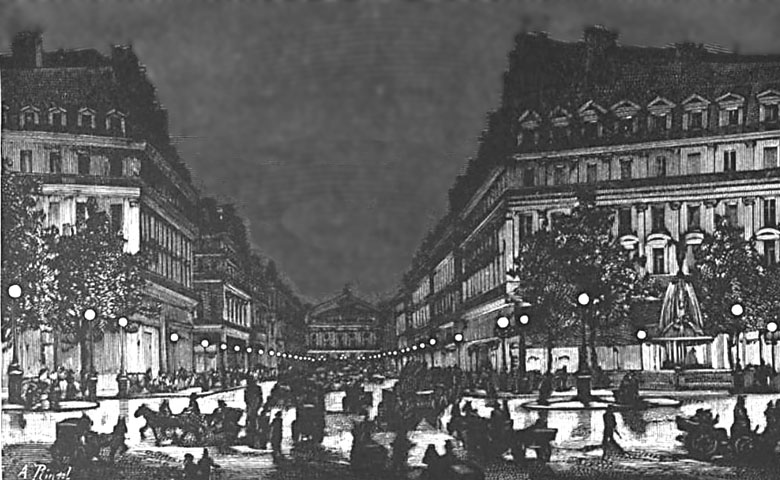 Yablochkov candles illuminating Avenue de l’Opéra in Paris under the Exposition Universelle (1878).
Yablochkov candles illuminating Avenue de l’Opéra in Paris under the Exposition Universelle (1878).
To ‘Rambler’, electric lighting lit the way forward; the future for gas lighting was therefore dim.
He outlined what he foresaw for Ilkeston ….
“Gas Company share purchase cancelled – despair of shareholders – brilliant illumination of the whole of the parish from the Church tower – Gasworks converted into almshouses for ruined shareholders – the gasometers converted into tankers for the new sewage ‘collections’ – the rest of the antiquated material to be sold to assist in defraying the cost of the journey to Paris”.
The Sheffield Telegraph was convinced that once the electric light was perfected “gas-works will sink into insignificance, and gas shares (will) become, like white elephants, pleasing to gaze upon, but ruinous to the possessor”.
A few days before Rambler’s Pioneer article a football match had been played ‘under electric lights’ between Birmingham and Nottingham, before a crowd of 2000 spectators, at Birmingham.
The result, by the way, was Birmingham 2 Nottingham 1.
P.S. In March 1882, Frederick Humphreys, manager of the Ilkeston Gasworks, gave a talk to the Church Mutual Improvement Society (of which he was the secretary) on the electric light, “aided by a number of diagrams on a black board, illustrating the various kinds of electric machines which have recently been invented”.
“The speaker did not think any of the lights would supersede the present system of gas illumination, particularly for domestic purposes, unless it were incandescent”. (IA March 11th 1882) Well, he would, wouldn’t he ?!?
1879. Finance and purchase
Finding a loan on acceptable terms with a competitive rate of interest proved difficult for the members of the Board. They initially declined the offer from the Public Loan Commissioners and sought to find other sources.
Begging pleas in the Pioneer for persons to come forward with ‘£100 and upwards to lend’ to the Board reaped insufficient response.
Tatler – a colleague of Rambler at the Pioneer – proposed (February 1879) the formation of a Ratepayers’ Protection Society to detect and highlight any future profligacy on the part of the Local Board.
“Ilkeston suffers more than any place I know of from ‘family’ government – from ‘sub rosa’(secret) arrangements and jobbery of all kinds – and unless more spirit is thrown into public affairs by the people who have to provide the funds, we shall see ourselves saddled with rates and taxes to such an extent as will render living in the place next to an impossibility”.
The leader of the ‘Family Party’ on the Local Board was William Sudbury, who attended only two Board meetings during the year 1878/79.
By March 1879 loan offers had been received by the Local Board from the United Patriots National Benefit Society, the Northern Assurance Company and the Penny Bank, all based in London.
And by the end of that month the Gasworks had been handed over to the Board, when the sum of £25,600 was paid.
It was at that time that the acquisition had been delayed partly because of ‘the fear which some timid persons have that the Electric Light will supersede Gas, and this renders gas undertakings comparatively valueless’.
Almost immediately after its purchase of the Gas Company, the Board set out plans to extend and alter the Works in order to raise the quantity and quality of gas produced. And to do the same for the main pipes, particularly as about one third of the gas produced was at present being wasted. The Stanton Iron Company was to be supplied with gas and this would necessitate the laying of a large number of new mains pipes.
This Gasworks extension meant that the Board had to apply for yet another loan – and you can guess what the Pioneer thought of that!!
“There are no bounds to the wealth of the parish, and no limit to the borrowing propensities of the gentlemen who are supposed to act on behalf of the ratepayers”.(IP August 1879)
Another inquiry by a Local Government Board Inspector recommended that the Ilkeston Board should borrow £7,500 rather than the £4,400 it had originally estimated to pay for the enlargement of the works – a recommendation which the Board (eagerly?) accepted.
At this point the Pioneer made some sarcastic reference to Adam Smith’s ‘Wealth of Nations’!!
In April 1879 Tatler of the Pioneer was almost pulling his hair out – the recent elections for the Local Board had confirmed the ‘Yellow’ (Liberal) dominance on the Board. He had wanted some ‘new blood’ (i.e. Conservative members) on the Board and was certain that his view was shared by a goodly number of Ilkeston ratepayers, who simply had not put enough energy and will into the electoral contest. Less than half the ratepayers had bothered to vote. What was needed in future was more diligence and ‘esprit de corps’, if the candidates for the ‘Family Party’ on the Board, “who now reign supreme over the destinies of Ilkeston”, were to be ousted.
Tatler foresaw a bleak future.
“Our town is being fearfully hampered with speculative operations, rash schemes and heavy rates.
“Our future prospects are imperilled by the responsibilities undertaken on our behalf by a board which is deaf to entreaty and blind to reason, and we are being held up by our neighbours as a warning to others to avoid the delusive paths we have trodden….
“… the whole parish is suffering from the combined effects of depressed trade and undue taxation, … many shops and business premises are unlet and unproductive – and in the face of these glaring facts, it is eminently desirable that a policy of retrenchment and economy should be inaugurated without delay.
“It is to be hoped that …. during the ensuing year we may be afforded a little breathing time to recover from the effects of the undue pressure put upon us during the past twelve months”.
In other words, we must take difficult decisions to deal with the deficit left to us by the previous administration.
And on New Year’s Day 1880 the same newspaper was ready with another broadside to fire at the Local Board.
It accused“our amateur gas manufacturers” of supplying inferior gas of insufficient illuminating power. The inhabitants of Ilkeston had paid dearly “for experimental gas making and water supplying, but it is time to put an end to amateurish mismanagement and proved incompetency. The folly of putting square men into round holes, and expecting them to fit exactly, has been abundantly manifest over the Gas and Water fiascos”.
And, of course, the newspaper could always rely on a number of compliant letter-writers to add their complaints, as, for example ‘Gas Consumer’….
“Are the Gas and Waterworks of the parish in the hands of amateur paper-hangers learning to manage at the expense of the ratepayers? The gas continues intolerable in quality, and in burning emits so much smoke that walls and ceilings require to be papered every three months. The reflectors over gas burners are black as a chimney in 10 or 20 minutes after gas is lighted”.
At the beginning of the year the irate ‘Gas Consumer’ had had a go at the Local Board through the pages of the Pioneer. Now, at the end of the year, it was ‘A Poisoned Workman’s’ turn.
“Sir – Some time past the Board supplied the town with a filthy poisonous compound called water: now they are poisoning us with gas. The horrid stink arising from the consumption of gas in shops, factories, and private houses, is most unhealthy and unbearable. It has made very many of the inhabitants seriously ill, its smell is a thousand times worse than sewage. Mr. Wood, the medical officer of health, ought certainly to be called upon for a report on the subject. A hundred pigstyes, ashpits, and privies, in their foulest state, could not emit a worse stench than that which everybody who uses the gas is every morning and evening compelled to breathe….
“Surely it is time our BOARD of MISMANAGEMENT and officials were sent to the left, and their places filled with men who will show some regard for the interests of the parish”.
1882-1885. Expansion
In March 1882, Frederick Chilton Humphreys was appointed manager of the Local Board gasworks at an annual salary of £120. At the same time plans and specifications for a new gasholder at Rutland Street were to be drawn up by Aylwin Harold Loam of Basford gasworks; it was completed six months later, built by Messrs Porter & Co. of Lincoln.
And then in the following month — November 1882 — the Local Board was at it again. Now it had plans for additional works to the town’s gas supply and wanted to borrow £4500 to finance the expansion which had already begun. This meant that another inquiry was needed and another inspector from the Local Government Board (Stephen Smith) arrived in town. He was not impressed by the fact that the Local Board had begun its work before gettingthe approval of its higher authority.
In March 1885, the Local Board advertised for tenders from persons willing to build a new Retort House, Retort Beds, Fitting Shop, Chimney Shaft, and other buildings at the town’s Gas works.
Frederick Shaw of the Manor House was chosen to build all the new brickwork, while John Whitehouse of the Midland Boiler and Engineering Works in Rutland Street was chosen to complete all the ironwork. Then Frederick discovered that he’d made a ‘clerical error‘ in his estimate and could he now submit a revised, accurate estimate ?!? What a to-do !!
The Local Board stuck to its guns — Frederick would either have to agree to his original estimate or the process would start again. Fred refused to budge and so in April 1885 the same advert for tenders appeared in the local press (with different dates included) !! And wouldn’t you just know it ?! … the same builder was chosen once more .. and hopefully, this time, he had recorded his figures correctly.
The Local Board now applied to borrow £2300 to cover the cost of expanding the Gas Works. But don’t forget, that it had already borrowed £38760 for previous schemes (see above). So how much of that had been paid off ? £1151 came back the answer.
So another inquiry had to be held at Ilkeston with the Inspector of the Local Government Board (S.H.Terry) at which lots of figures pertaining to gas output and prices, income, revenue and loan debt were exchanged — all carefully explained by Frederick Chilton Humphreys. The further loan was requested and a few days later the request was granted, the loan to be repaid over 30 years.
Not only did Frederick Shaw have trouble in tendering for this work, but his problems continued after it had begun. A couple of months into the job and an iron roof that Frederick was placing over the new retort house and coal store was found not to fit. As it was being removed it crashed to the ground, upon Frederick’s son, Frederick junior, and another worker. The former received severe injuries to his head.
The Town Council takes up the reins
1888: And yet more figures !!
Ten years after the Gasworks purchase of 1877/78 a total of £42,060 had been borrowed — this included the initial purchase price of around £26000, as well as the finance for six extensions to the works costing over £15000.
When it was purchased, there were four purifiers, a retort house, condenser, meter, and two gas-holders. Now, ten years later, there was an enlarged retort house, a condenser, two engines, two boilers, a washer, four enlarged purifiers, a sulphate ammonia plant, two gas-holders, storerooms, workshops, weigh-bridge, and testing apparatus.
The new Town Council was able to produce all kinds of figures to show that, on every metric, gas production in Ilkeston was now much more efficient and profitable under Municipal control than it was when supplied by the private Gas Company. There were now 1078 gas customers and 223 public lamps, and output was increasing by 9% annually. Time therefore for more alterations and additions … and more loans ? So in June 1888, the Council asked for permission to borrow an extra £6000.
———————————————————————————————————————————
1890: We’re cooking with gas (Part 1) !!!
In May 1890 an exhibition of gas cooking appliances was opened by the Mayor, William Tatham, at the Market Hall in the Market Place. It was accompanied by a series of cookery lectures on using gas stoves in the home. Other gas appliances and lights were also on show.
———————————————————————————————————————————
1895: What to do with the tar ?
Frederick Chilton Humphreys, manager of the Rutland Street gas works, had turned his attention to the excess tar, a by product in the manufacture of coal gas. At his Ilkeston works he had replaced the relatively expensive coke with this valueless tar in the heating of his retorts, having calculated that using the coke cost 4s 6d per day for each retort; using tar however cost only 3s, a clear saving of 1s 6d on each furnace. Frederick was aware that tar prices could rise, and if or when they did, he would advise selling it rather than using it as heating fuel. And Frederick was prepared to share his idea as widely as he could … hence the appearance, in the “American Manufacturer and Iron World“, of his article on “Liquid Fuel in the Retort House”.
1895: More improvements
By June of 1895 the Town Council needed another loan — of £4000 — for its proposed gas works. Time for the ‘begging bowl’ once more .. and for another public inquiry !!!
A new gas main: If we look back about 40 years, to the town in the 1850s, we can see that there had been much discussion about Ilkeston’s street lighting. At that time, one of the first gas mains laid by the old Gas Company was the one in Bath Street which ran from the Gas Works in Rutland Street up to the Market Place — and as it made its way ‘uptown’ its diameter decreased. It started off as an 8in pipe, then decreased gradually by an inch each time, until it was only 4in at the top of the street. The reasoning was that there were fewer houses to supply as the route progressed, and therefore no need for larger pipes. And the pipe which continued down South Street (and was as old as the Bath Street one) was alsoonly 4in in diameter.
These gas mains were now past their ‘sell-by’ date and the Council proposed a new 12in pipe for Bath Street and a 6in one for South Street
The Hallam Fields Issue: The Stanton Company had made an offer to supply gas to every house in Hallam Fields and to pay for the consumption with a lump sum …. so long as the Town Council laid the gas mains in the streets there. The Gas Committee of the Council had rejected this offer and Wright Lissett, the Clerk, had to explain why this seemingly generous offer had been refused, to the rest of the Council. His reason was that the Gas Committee did not lay gas pipes in streets which were not public or had any reasonable possibility that they would become public. For example, if a pipe needed mending in a private road, the Council would need permission before it could access the problem. Edwin Trueman pointed out that about 150 houses were affected — surely the Council could lay mains in the streets ?!? The Clerk replied that they would gladly do this in public roads and then supply a large meter to the Stanton Company for their houses. This seemed a sensible proposal to the majority of the Council members and so plans were made !
A gas main would be laid in Corporation Road to supply the Hallam Fields residents. This road had been built in 1888 and the area now had a population of about 600 – 700 folk who thought it time for them to be treated like the rest of the town. Because of the topology of the town it was impossible to pass gas from Rutland Street, up Bath Street, and then down Nottingham Road and then around Hallam Fields without the risk of leaks resulting from the pressure needed to do this. So the Council would supply the area from a gas holder placed in Hallam Lane, on land leased from the Duke of Rutland, and then run a 6in pipe to Hallam Fields. Around Hallam Fields, 5in, 4in and 3in pipes would be used. Fortunately the Council had an old holder at the gas works which was too small and now practically useless for the rest of the town. It could be used on Hallam Lane, thus cutting down the overall cost of the scheme. The holder would be filled up during the day, and then the gas would be used at night, to supply Hallam Fields and part of lower Nottingham Road. At Hallam Lane new buildings would be erected to house the engine, the exhauster, tools, etc. and a caretaker’s house.
Changes to the Rutland Street Works: Once the old holder had been removed from the Rutland Street works, a new larger, 100,000 cubic feet holder could be built there (The old one was only 36,000 cubic feet). The other holder at the works had a capacity of 200,000 cubic feet which would be extended by an extra 100,000 cubic feet. Altogether this would give the town an extra 240,000 cubic feet of storage (almost).
In the winter time, because of limitations at the works, it had been discovered that sufficient gas of an illuminating power to satisfy customers could not be produced. So, an ‘enrichment plant‘ had been built there (already !!) to increase the gas’s illuminating power … and what a great success this had been. But it now needed paying for.
The total cost: the Town Council had totted up all this expenditure and presented a total bill of £3990 17s to the Local Government Board Inspector, Mr. Codrington, who was at the Town Hall meeting on June 14th, to assess the scheme and the loan. Frederick Chilton Humphreys, the manager of the gas works, was on hand to explain all the technicalities and diagrams. After that the Inspector wandered off to inspect the works and ponder the loan.
1896: We’re cooking with gas (Part 2) !!!
Another exhibition of gas-cooking appliances, this one in the South Street schoolrooms, was opened by the Mayor in April, to last for four days, with most of the Town Council in attendance. There, to view, were 17 cooking stoves and a number of gas fires as well as several labour-saving gas appliances. The stoves were available for rent from the Corporation, with free fitting !! — prices ranging from 6d to 5s per quarter !! Beatrice Shaw (first class diploma, Nottingham School of Cookery) was on hand to give daily practical lectures on cooking by gas.
March 1899 – March 1900: More gas expansion
At a Council meeting in March 1899 a motion was provisionally passed to buy land and houses at the rear of the Rutland Street Gas Works, subject to the approval of the Local Government Board (i.e. approval to the purchase and to the raising of a loan to pay for it, and for any improvements needed).
This land and property (right) had previously been owned by the late Samuel Whitehead and George Swanwick, a total of 34 dwelling houses and adjoining land, on the north side of the Works (known as Springfield Street, though the houses were sometimes referred to as Springfield Terrace)
This plan and the loan of about £4000 needed for it were finally discussed at a Public Enquiry in March 1900.
At the Enquiry it was noted that in March 1882 the Gas Works supplied 26 million cubic feet of gas to 617 customers and 134 street lamps. Now, in 1900, it supplied over 70 million cubic feet to 2200 customers and 382 street lamps. In the last year alone, an extra 7 million cubic feet had been supplied, and demand was almost certain to increase by the same amount in future years. New purifiers, an additional washer, extra storage capacity for coke and coal, additional railway sidings, a new meter and exhauster — all were needed according to Town Clerk Wright Lissett. The land adjoining the present works was ideal for such expansion, at an estimated cost of £4400. (This included the cost of enfranchisement of one portion of the property which at present was copyhold).
Some in the town were not pleased by the attitude of some Council members over this issue ..
Mentioned in the article, Alderman Robinson was the ex-mayor Samuel (above): the ‘useless’ water scheme referred to was the on-going boring project at Little Hallam, which had cost so much yet had produced so little.
———————————————————————————————————————————
Twenty-first century postscript
Taken from the Derbyshire Historic Environment Record — Monument record MDR5842 – Gas Works (site of), Rutland Street, Ilkeston — on the Derbyshire County Council website (2020)
Ilkeston’s gas works, built to create gas from local coal, were moved to this site in c. 1869, having initially been established near the junction of Bath Street and Rutland Street. The works have been demolished, with the exception of a single ornate brick building, probably a retort house of c. 1909/1910.
The 1st and 2 eds 25″ OS maps show the works bounded to the east by a plot containing what is interpreted as a short row of terraced housing and to the north by a longer terrace of houses, Springfield Terrace. In the early 20th century the 3rd edition OS map shows that the gas works were connected to the railway by tracks running across Bellfield Street. Springfield Terrace had been demolished and the works appear to have expanded northwards across the site of the building.
The retort house was built in 1909 as part of the Ilkeston Corporation Gas Works. After the local manufacture of gas ceased in the 1950s the building was used by various light engineering concerns, including Leisure Sales, makers of fairground machines. A second retort house, built in 1937, was demolished in the late 1960s.
Archaeological trial trenching was carried out on the former gas works site at Ilkeston in November 2012. Three trenches were excavated in the southeastern corner of the site prior to the construction of a restaurant and associated car park. A large curving wall that formed the base of Number 2 gas holder was revealed in trench 1 in the west of the excavation area. A smaller circular brick walled structure reminiscent of a chimney or possibly a tar well was also recorded just to the south of this. The original smaller Number 2 Gas Holder is likely to have been lost during the constrcution of the later structure. Walls and floor surfaces of further associated structures were uncovered in trench 2 in the south. The structures fronting Rutland Street may have been domestic properties, possibly for gas workers; however, the presence of brick floors and possible brick pillars points to an industrial use. The foundations and sandstone sett surfaces of the historic Dry Gas Plant building and the Governor’s House were revealed in trench 3, in the east of the excavated area.
————————————————————————————————————————————————–
Now, to many ratepayers and to the Pioneer, after a period of such profligacy, it was time for reform, economy, retrenchment and efficiency.

